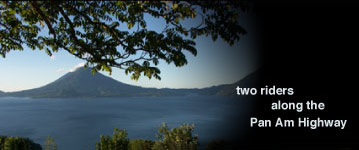
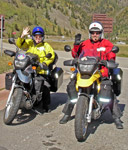
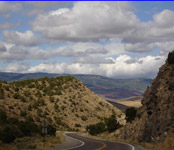
view corresponding gallery | previous entry | next entry
entry 12: pachuca, mexico to oaxaca, mexico 12/28/05
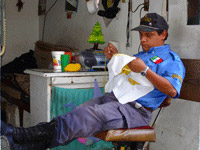 |
| The man guarding our bikes in Pachuca. That's a Winnie-the-Pooh he's embroidering. |
Leaving San Miguel and its gorgeous zocolos (plazas) we headed southeast - taking roads that would allow us to bypass Mexico City. In Italy they say “all roads lead to Rome” and you could say the same for Mexico City - except the road signs refer to the city of 18 million as only “Mexico”, which at first was a little confusing since we had been traveling for a month in a country with the same name. We stopped that night in the town of Pachuca and for the first time it felt like we were really in Mexico! I know that might sound strange but we had landed in a town where no one we encountered spoke English. Lynne did most of the talking and did a great job of finding us a hotel room and dinner. It really is amazing how many people in Mexico are bi-lingual, which is either a great credit to there abilities or an indicator of the influence the U.S. has on their culture.
We started our next day the way we usually do, that is to say eating a breakfast that consists of saltines and peanut butter, a banana or orange and of course water, vitamins and a Coke. In-room coffee service, better known as a Mr. Coffee machine, stopped existing at inexpensive hotels after we crossed into Baja and let’s just say I have had some mornings that would have gone better with a cup of joe rather than a Coke. The next day we traveled along roads that kept us about 100 miles to the east of Mexico City but the volume of traffic was still noticeably heavier and there were plenty of heavy trucks and buses. Our day ended in the city of Puebla, population of about 1.5 million, and loaded with churches and streets bustling with shoppers. Sometimes it feels like we navigate the streets on bikes that are too overloaded with gear and we struggle, sweat and swear - but then you get passed by a 90cc moped transporting a father, mother, and two young kids, plus bags from the days shopping. All of a sudden things are put back into perspective and the urban crawl becomes a little easier. Puebla has great people-watching street malls that perpetuate the theme of half of the stores being shoe shops. The streets have vendors selling helium-filled balloons and every corner has a pot of boiling water with cobs of corn in them. I haven’t tried any food from street merchants yet but it does smell great when you walking by.
You may notice that I do not give an exact route or road number when writing. There are two reasons for this - the first is because I think people should choose their own roads when traveling for adventure. There are many roads from Canada to the tip of South America and each route has its own challenges. The second reason is that I have a real problem with road numbers! For example, the AAA map of Mexico (2005 edition) does a fairly good job of showing the main and secondary roads but as we left the town of Tehuacan a few days later, heading for Oaxaca, the map indicated that the most direct route would be Highway 131. It was marked in bold black lines, which should indicate a main road. Not always trusting the map, I pulled out the GPS before taking off and confirmed the highway was number 131. So we take off from the hotel, zigzagging around traffic and we see a large green sign that reads “Oaxaca” with an arrow pointing straight ahead. We follow the road around a long sweeping corner and I’m thinking “funny how light the traffic is” and wham! Crap! - nothing but road construction as far as the eye can see. Traffic is one lane gravel/sand and wash boards big enough to bottom out the shocks. Relieved that it only lasts a mile we continue our ride on pavement that has patches on the patches and then we hit more road construction. Holy smokes! More dirt action with some gravel/tar mixture thrown in for another half mile or so. We now have been riding for about 45 minutes, have covered 5 miles in 85 degree weather and we have yet to see a Highway 131 road sign. Traffic is still terribly light and as we head south, the general direction of Oaxaca , we are wondering what highway this is and why are there no road signs? Several miles later the choppy road finally reveals a road marker, which informs us that we are on Highway 920. 920??? Where in the world did that come from? Stopping to check the map and GPS I find towns that we have passed (all start with a “Te” and end in “xan”, just to add to the confusion) but I’m fairly certain we are on the right road. After another 40 miles we have passed two more highway markers, neither one being 131. We pass through sugar fields, some burning (don’t know why), some being harvested and hauled off by old lumbering trucks that share their loads by dropping a bundle of cane on the road now and then.
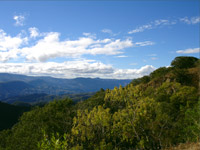 |
| Views like this in the Sierra Madre mountains make riding time pass much more quickly. |
We finally pass into the state of Oaxaca and Lynne asks the friendly (and he really was friendly) federal policeman (read para-military), armed with what appeared to be some type of machine-gun, if we are headed to the city of Oaxaca. “Oh, yes” he says, “but why didn’t you take the Autopista (toll road)? O.K, I did see that road on the map but it was a route that was would have added about 40 miles to our ride. And yes, I realize the shorter road is not always the quickest - but come on, how much longer could it take us to get to the city of Oaxaca? The road signs were now telling us we were on Highway 135 and the maps still insisting we were on 131 - but the pavement had smoothed out a bit and the big trucks disappeared, so we continued on. We were now riding into the heart of the Eastern Sierra Madres, a continuing chain of the Rocky Mountains where the road climbs from 5,000 feet to 8,000 feet. For the next three hours we were on a road that overlooks some of the most spectacular valley views we have seen so far, while on switchback roads where your speed never exceeds 35 mph. The ride was fantastic but those last three hours required several stops to rest our rear-ends and give our minds a break from constantly concentrating on the road.
 |
| Reminders of Christmas in Denver make an appearance poolside in Oaxaca. |
Christmas in Oaxaca gave us a chance to reflect on our trip to date and also let us experience first-hand how Christmas is celebrated in another part of the world. Christmas in Mexico is unique to say the least, but even though we were surrounded with new sites and traditions, Christmas has made us homesick and a little depressed. I miss the Salvation Army bell ringers and our neighbors, Rob and Mike, whose annual over-the-top display of lights and ornaments would occasionally dim the neighborhood street lights. Christmas Day was spent mostly in our hotel, although I have to admit I felt in better spirits after setting up our mini-Nativity scene down at the pool. The Nativity was loaned to us from good friends Dan and Bill when we left Denver. The set made the entire trip in our panniers and totally made our day when they emerged on Christmas day. Thanks guys! Christmas here is celebrated as a religious holy day without the entire huge gift giving that is done in the US of A. However, (and Lynne really liked this idea), the twelve days of Christmas are celebrated starting on the 26th and ending on the 6th of January, known as Three Kings Day. Gifts are given to children on this day and families serve a King Cake, which is shaped in a circle and has a small plastic toy baked into it. Whoever gets the toy in their slice of cake has to host a party on the 2nd of February for all those in attendance - called the Day of the Candle. The host serves tamales and chocolates to everyone. These people know how to make the most of a holiday!
The last 3 ½ months have gone by quickly and although we have enjoyed many of the places we have visited, we feel we haven't been able to develop relationships other than the superfluous. This is possible due to the fact that we’re not spending enough time in one place – and also our lack of Spanish fluency prohibits “moving to the next level” with the people we do meet. We hope to address both of these issues in the near future. Towns are starting to run together and the novelty of warm soda and refried beans is starting to wear off. But just as everything seems to be commonplace, something will strike me as unusual. For instance, buying bread has become something reminiscent of the Seinfeld “Soup Nazi” episode. In every town, we enter the panaderia (bakery), grab a tray and tongs, and walk around placing fresh baked goodies on our tray. The odd part is when you go up to the counter to checkout. The first person ignores your hello (this has happened at almost all of the bakeries) and says nothing as they robotically place your purchases in a bag. Without a word they hand you a ticket and you move to the cashier, who also says nothing while systematically taking you money and making change. It’s as if they are not allowed to talk to the customer or each other. Only churches have been more somber. But make no mistake, the bread and most pastries have been delicious.
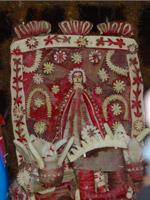 |
| A radish depiction of the Virgin of Guadalupe at Noche de Rabanos. |
One of the most interesting events we attended was a few days before Christmas, 8 o’clock in the evening on the 23rd to be exact. It is called Noche de Rabanos (Night of the Radishes) and as the name would indicate radishes are the main event. The radish was introduced to the Oaxaca region by the Spaniards in the 16 th century and Friars encouraged the farmers to make figurines out of the radishes to promote interest in the new produce. This practice gained so much popularity in the region that in 1897 the first festival was held that included a contest for the most creative radish display. This year the winner took home $12,000 pesos or about $1,200 US. The festival has expanded to also include displays of dried flowers and cornhusks. We didn’t get a real close look because the line to do that was (get this) over a half mile long! But being relatively tall allowed us to see most of the displays from about 15 feet away.
Well, Christmas is over and now we are off to Veracruz to ring in the New Year. Just have to pack the bikes again and load up the gear. Packing tip…buy the bungee cargo nets with the thick cords. It’s amazing how much you can attach to your bike - I like to call it “feeding the whales”.

Copyright © 2005 All content and photography are the property of Tom and Lynne Gefre.
Contact us if interested in publishing or reusing any material.